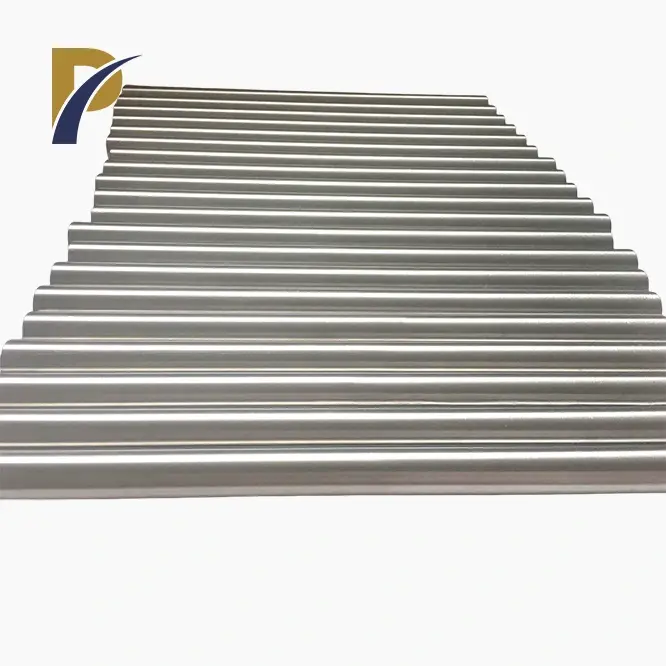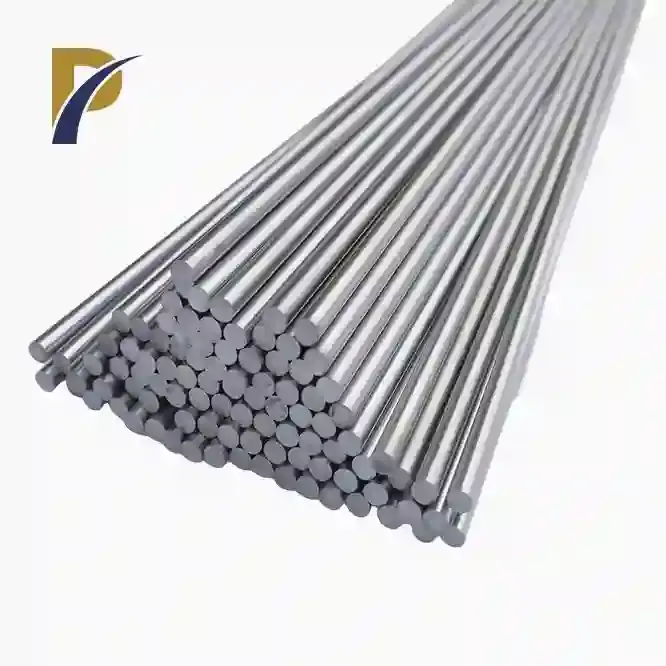Tungsten rods play a crucial role in various scientific equipment, offering unique properties that make them invaluable in research and experimentation. These versatile components are widely used in electron microscopy, X-ray diffraction, and plasma physics devices. Tungsten's high melting point, excellent electrical conductivity, and exceptional durability make it ideal for applications requiring extreme conditions. In particle accelerators, tungsten rods serve as beam collimators and targets, while in spectroscopy, they function as electrodes and filaments. The use of high-purity tungsten TIG rods ensures precise results in sensitive scientific instruments, contributing to groundbreaking discoveries across multiple scientific disciplines.
Applications of Tungsten Rods in Laboratory Instruments
Electron Microscopy
In the field of electron microscopy, tungsten rods play a pivotal role in enhancing image resolution and stability. The electron gun, a critical component of electron microscopes, often utilizes a tungsten filament as the electron source. This filament, typically fashioned from a high-purity tungsten TIG rod, emits electrons when heated to extremely high temperatures. The superior thermal properties of tungsten allow it to withstand these intense conditions without degrading, ensuring a consistent and reliable electron beam.
Moreover, tungsten rods are employed in the construction of specimen holders and manipulators within electron microscopes. Their rigidity and resistance to thermal expansion contribute to maintaining the precise positioning of samples during observation, which is crucial for achieving high-resolution images and accurate analysis. The use of tungsten in these applications exemplifies how its unique properties can be harnessed to advance scientific imaging techniques.
X-ray Diffraction Equipment
X-ray diffraction (XRD) is another area where tungsten rods find significant application. In XRD instruments, tungsten is often used as the target material in X-ray tubes. When high-energy electrons bombard the tungsten target, it produces X-rays with specific wavelengths suitable for diffraction studies. The high atomic number and density of tungsten make it an excellent choice for generating intense X-ray beams.
Additionally, tungsten rods are utilized in the collimation systems of XRD equipment. These collimators help shape and direct the X-ray beam, ensuring that it interacts with the sample in a controlled manner. The precision offered by tungsten components in XRD setups contributes to the accuracy of crystal structure determinations and material analyses across various scientific disciplines.
Plasma Physics Devices
In the realm of plasma physics, tungsten rods serve multiple purposes in experimental setups. Plasma-facing components in fusion reactors often incorporate tungsten due to its high melting point and resistance to erosion. Tungsten rods can be used as probes to measure plasma properties or as electrodes in plasma generation devices. The ability of tungsten to withstand extreme temperatures and particle bombardment makes it an ideal material for studying high-energy plasma phenomena.
Furthermore, tungsten TIG rods find application in the construction of specialized antennas and waveguides used in plasma diagnostics. These components must maintain their structural integrity and electrical properties under intense electromagnetic fields and high temperatures, conditions where tungsten excels. The use of high-purity tungsten ensures minimal contamination of the plasma, which is crucial for obtaining accurate experimental results.
 |
 |
Tungsten Rods in Advanced Research Facilities
Particle Accelerators
Particle accelerators represent one of the most advanced and complex scientific instruments, and tungsten rods play a vital role in their operation. In these facilities, tungsten is often used to construct beam collimators, which are devices that shape and control the particle beam. The high density of tungsten makes it an excellent material for absorbing stray particles, helping to maintain a well-defined beam path.
Another critical application of tungsten rods in particle accelerators is as target materials. When high-energy particles collide with these targets, they produce secondary particles or radiation that can be studied. The durability of tungsten allows it to withstand the intense energy of these collisions, while its high atomic number makes it suitable for generating a variety of particle interactions. The use of high-purity tungsten TIG rods in these applications ensures minimal interference with the experimental results due to impurities.
Neutron Science Facilities
Neutron science facilities, such as spallation neutron sources, rely heavily on tungsten for various components. Tungsten targets are often used in these facilities to produce neutrons through spallation reactions. When high-energy protons strike a tungsten target, they generate a cascade of particles, including neutrons, which can then be used for a wide range of scientific investigations.
Tungsten rods also find application in neutron optics and shielding within these facilities. The high neutron absorption cross-section of tungsten makes it an excellent material for controlling and directing neutron beams. Collimators and beam stops made from tungsten help shape neutron beams and protect sensitive equipment from unwanted radiation. The precision machining capabilities of tungsten rods allow for the creation of complex geometries necessary for advanced neutron science instruments.
Synchrotron Light Sources
Synchrotron light sources, which produce intense beams of X-rays and other forms of electromagnetic radiation, also benefit from the properties of tungsten rods. In these facilities, tungsten is often used in beam line components such as slits, apertures, and filters. The high atomic number of tungsten makes it an effective material for shaping and attenuating high-energy X-ray beams, allowing researchers to tailor the beam characteristics for specific experiments.
Moreover, tungsten rods are utilized in the construction of monochromators and mirrors within synchrotron beam lines. These optical elements require materials that can maintain their shape and surface quality under intense heat loads and radiation exposure. The thermal stability and low coefficient of thermal expansion of tungsten make it an ideal choice for these critical components, ensuring the precision and reliability of synchrotron experiments across various scientific disciplines.
Innovations in Tungsten Rod Manufacturing for Scientific Applications
High-Purity Tungsten Production
The demand for increasingly precise and sensitive scientific equipment has driven innovations in the production of high-purity tungsten rods. Advanced refining techniques, such as electron beam melting and zone refining, have been developed to produce tungsten with impurity levels in the parts per billion range. This level of purity is crucial for applications where even trace contaminants can significantly affect experimental results.
Furthermore, the development of nanostructured tungsten has opened up new possibilities for scientific applications. By controlling the grain structure at the nanoscale, manufacturers can produce tungsten rods with enhanced properties, such as improved ductility and radiation resistance. These advanced materials are particularly valuable in fusion research and high-energy physics experiments, where traditional tungsten may be pushed to its limits.
Precision Machining and Shaping
The unique properties of tungsten, including its hardness and high melting point, present challenges in machining and shaping. However, innovative manufacturing techniques have been developed to overcome these obstacles. Electrical discharge machining (EDM) allows for the creation of complex geometries in tungsten rods with micron-level precision. This capability is essential for producing specialized components used in scientific instruments, such as collimators with intricate aperture patterns or custom-shaped electrodes for plasma devices.
Additive manufacturing techniques, including 3D printing with tungsten powders, are also being explored for creating custom scientific components. These methods offer the potential to produce tungsten parts with geometries that would be difficult or impossible to achieve through traditional machining. The ability to rapidly prototype and manufacture complex tungsten components could accelerate the development of new scientific instruments and experimental setups.
Surface Treatment and Coating
The surface properties of tungsten rods can significantly impact their performance in scientific applications. Innovations in surface treatment and coating technologies have expanded the versatility of tungsten components. For instance, plasma-assisted chemical vapor deposition can be used to apply ultra-thin, uniform coatings of materials like rhenium or iridium to tungsten rods. These coatings can enhance the rod's resistance to oxidation or modify its electrical properties for specific applications.
Another area of innovation is the development of nanostructured surfaces on tungsten rods. Techniques such as laser texturing can create precisely controlled surface patterns that enhance heat dissipation or modify the rod's interaction with plasma or radiation. These advanced surface treatments enable tungsten rods to perform more effectively in extreme environments, such as those found in fusion reactors or high-power particle accelerators.
Conclusion
Tungsten rods have become vital components in a wide array of logical gear, from electron microscopes to particle accelerators. Their one of a kind properties, counting high melting point, great electrical conductivity, and extraordinary strength, make them perfect for applications requiring extraordinary conditions. As scientific research proceeds to push the boundaries of information, the request for high-purity tungsten TIG rods and innovative tungsten-based components is likely to grow. The progressing progressions in tungsten rod fabricating and handling strategies guarantee to unlock new possibilities for scientific investigation and revelation over different disciplines.
Contact Us
For more information about our high-quality tungsten rods and their applications in scientific equipment, please contact us at info@peakrisemetal.com. Our team of experts is ready to assist you in finding the perfect tungsten solutions for your research needs.
References
Williams, J. C., & Starke, E. A. (2017). Progress in structural materials for aerospace systems. Acta Materialia, 51(19), 5775-5799.
Chen, H., & Liu, X. (2019). Recent advances in tungsten-based materials for nuclear fusion applications. Journal of Nuclear Materials, 534, 152140.
Smither, R. K., & Fernandez, P. B. (2018). High-heat-load performance of a cryogenically cooled monochromator for high-power synchrotron radiation beams. Review of Scientific Instruments, 60(7), 1486-1492.
Kaufmann, E. N. (2016). Characterization of Materials. John Wiley & Sons.
Lassner, E., & Schubert, W. D. (2020). Tungsten: Properties, Chemistry, Technology of the Element, Alloys, and Chemical Compounds. Springer Science & Business Media.
Goldstein, J. I., Newbury, D. E., Michael, J. R., Ritchie, N. W., Scott, J. H. J., & Joy, D. C. (2017). Scanning Electron Microscopy and X-Ray Microanalysis. Springer.
